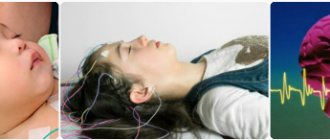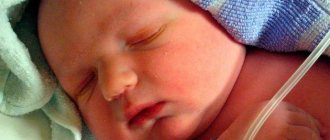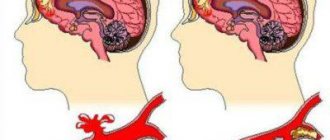January 15, 2020 Admin Home page » MRI and CT scan of the brain Views: 6022
First, it is necessary to consider the general indications for which an MRI of the child’s brain may be prescribed. Magnetic resonance imaging is a study that can most accurately detect diseases of the brain, as well as cranial nerves and blood vessels in the early stages. This study has the highest degree of visualization and, accordingly, high diagnostic accuracy when it is necessary to detect the presence of tumors and many other brain injuries.
The doctor prescribes an MRI of the child’s brain when he experiences:
- frequent dizziness for no apparent reason and headaches;
- fainting;
- there is a decrease in the quality of vision and deterioration of hearing for unknown reasons;
- convulsions (even one-time);
- delayed development of psychomotor skills and speech;
- mood swings and causeless changes in behavior;
- brain concussion.
Features of the event
How an MRI is done for children: the scanning procedure is the same as for an adult. The child is placed on the tomograph table, and the laboratory assistant helps to create the desired position. After preparations, the table moves into the tomograph tunnel, the parents leave, and the scanning begins. The entire procedure takes on average 15 to 30 minutes. The scanning time depends on the indications and condition of the baby.
You may need to administer a contrast agent before the test. It's painless. The auxiliary agent contrasts the vessels, making the picture more detailed.
The scanner produces a quiet background noise during the scan. It is worth warning the child about this so that he is not afraid of unfamiliar sounds. If noise bothers you, you can ask for headphones with your own music or earplugs.
What will an MRI of a child's brain show?
MR diagnostic technology is capable of identifying anomalies in structure, size, the presence or absence of zonal parts of an organ, the appearance of foreign formations, etc. The following diseases and pathologies are defined:
- Infected areas of the brain, the exact location of the lesion and the area of adjacent lesions.
- Damaged areas of blood vessels. A complete picture of the vascular network makes it possible to determine in which area the damage occurred, which impedes normal blood supply (thrombi, aneurysms, ruptures, breaking kinks, places of hemorrhage, hematoma areas).
- Malignant and benign neoplasms. Even incipient abnormal tissue is visible at the initial stage of its appearance. If there are no noticeable tumors, specialists can determine the potential area for their appearance.
- A disorder in the pituitary gland that causes hormonal imbalance.
- Epileptic disorder. This disease is characterized by specific changes in brain tissue. Epilepsy can be diagnosed without the help of a tomograph, but the origins of the disease can only be learned by studying the internal structure of the patient’s brain. These could be tumor formations, vascular lesions, consequences of injury or infection.
- Brain hypoxia.
- Diseases of the inner ear and diseases of the eyeballs.
- Autism. When studying this disease, it was discovered that the “shell” of the brain tends to expand. Thanks to timely diagnosis of this symptom, you can help the child and reduce the severity of the disease.
- Brain cysts.
- Damage to nerve fibers.
How to prepare a child
On the way to the clinic, it is recommended that the parent explain the procedure and what will be expected during the scan. Tell them that the procedure is painless and not scary. Instill in your child that this is like a game, like an adventure. After arriving at the clinic, do not insist on immediate diagnosis. Take a walk with your baby around the nearest departments: let your child get used to the surroundings.
There is no special preparation for magnetic resonance imaging for a child, however, several prerequisites must be met before the procedure:
- Remove all metal objects and other things that could distort the image or become hot during scanning. Whether to remove braces depends on the material of the product.
- Remove phones and other electronic devices that distort the electromagnetic field.
For high-quality images, it is necessary that the child does not move during the procedure. If the child is nervous, parents should calm him down and be in the room with him before the scan begins. Some diagnostic centers allow parents to be present with the child during the brain examination. It is advisable that the baby is not hungry.
Preparing for the study
The procedure itself does not require special preparation. If anesthesia is planned, then you will have to visit the clinic to talk with an anesthesiologist before the study. The doctor will find out all the necessary information regarding contraindications to anesthesia. He will also give recommendations on preparing for the study.
Anesthesia is administered on an empty stomach; as a rule, it is performed in the morning. Therefore, you should not give your child food or drink before the procedure. The evening before the study, you must also refrain from eating dinner later than seven o'clock in the evening.
MRI under anesthesia is performed strictly on an empty stomach
If an MRI of the brain is planned without anesthesia, it is still not worth feeding the child before the study, since the child may vomit due to nervous overstrain. For MRI in the morning, dietary recommendations are the same as for anesthesia; if the study is scheduled in the afternoon, the last meal should be no later than six hours before the start of the procedure. The baby can be fed two hours before the test.
It is also necessary to limit excessive fluid intake during the last twelve hours before the MRI to prevent your child from needing to go to the toilet. Before the procedure, the child may be asked to visit the toilet.
It is necessary to prepare in advance the clothes that the child will wear inside the device: they should not contain metal rivets, buttons, hooks, or decorations. If the child has a pectoral cross or other metal elements, they must be removed.
Before entering the equipment room, you must remove the dental plate. You must tell the doctor who will conduct the examination in advance about the presence of braces; they may have to be temporarily removed.
Do you need anesthesia?
Anesthesia causes artificial drug-induced sleep. It is necessary for children under 3-4 years of age who do not yet understand the meaning of the procedure and find it difficult to explain what is happening. Older children (children 5 years old or older) who understand the requests of their parents and laboratory assistant do not require anesthesia.
During the procedure you need to lie still: any movement distorts the resulting picture. This is why it is so important not to move during the scan: anesthesia is administered to especially mobile and active children. It is difficult to order a child 3 years old or younger to lie still for 15 minutes.
The substance is administered by inhalation through a mask. First, for a few minutes, when anesthesia is administered through a mask, the child lies on the couch. When the baby falls asleep, the parents leave the office and the scanning begins. The amount of general anesthesia administered does not reach the harmful threshold, so artificial sleep is safe; children under anesthesia often undergo magnetic resonance imaging. During medicated sleep, a doctor monitors your vital signs. It monitors breathing rate, pulse and blood oxygen levels. After the procedure, the baby will not remember anything.
If the child is inactive, but is very worried, he is prescribed sedatives (calming agents).
MRI of the brain in an infant
If the baby is at an age when it is difficult for him to understand what is happening and what is expected of him, an MRI examination is performed under general anesthesia.
It was said above that obtaining a clear result is possible only with a completely static body position. The movements of a small child are involuntary. Anesthesia is the only way out.
Is MRI harmful?
Magnetic resonance imaging is a completely harmless method. There is no historical evidence that the magnetic field of a CT scanner has harmed the health of a child or an adult. This tomography is based on the action of a magnetic field. The procedure is carried out even for pregnant women, with the exception of the first trimester of gestation.
A standard magnetic tomograph has a power of 0.5 to 3 Tesla. This type of diagnostic device is not capable of harming the baby’s body.
Is it harmful to have an MRI? No, it is not harmful. The procedure is completely harmless and does not cause indirect side effects.
Contrast agents are the only thing that can harm a child’s health. If the baby has an individual intolerance to contrast components, there is a high probability of developing allergic reactions of varying complexity, from ordinary swelling and redness of the face to severe resuscitation conditions with breath holding.
However, to prevent allergies, a provocative test is usually done before the procedure - a microdose of the substance is administered and the skin reaction is assessed. If it is not there, contrast can be introduced. In addition, to prevent an undesirable reaction from the body, the child may be given antihistamines - these are substances that block the mechanism of allergy development when an allergen is introduced.
Anesthesia is not given to a child if he has a severe delay in psychomotor development, for example, the baby does not swallow, or reacts slowly to light, or his motor skills do not correspond to the age norm. For example, if a child is 6 years old and still has difficulty speaking.
Indications for MRI in children
This research method has many advantages compared to the equally popular ultrasound or CT:
- modern MRI allows you to obtain images of organs and systems in three planes for maximum diagnostic accuracy;
- thanks to computer processing and the peculiarities of the technique, it is possible to evaluate not only the structure, but also the composition of the tissues being studied;
- Carrying out an MRI of a child’s brain today is the most accurate and informative way to assess the state of the central nervous system.
Indications for MRI in a child:
- diseases, injuries of the brain or spinal cord;
- congenital malformations of internal organs, limbs, head;
- neoplasms of any localization.
In addition to an MRI of the child’s head, an examination of the spine, abdominal and retroperitoneal organs, pelvis, and joints is performed. Although the most popular is MRI of the brain in children, which provides the most complete information in comparison with other diagnostic methods.
If indicated, contrast agents may be used. These compounds are administered intravenously and “tint” the organs being examined and the vascular bed. The significance of contrast is especially noticeable in what an MRI of a child’s brain shows: with the help of auxiliary substances, lesions in the nervous tissue of a tumor or inflammatory origin become visible.
The information obtained during the study can be useful not only for making a diagnosis, but also for determining the further course of treatment. If surgical intervention is necessary, a tomogram allows you to think through and plan the course of the operation to achieve the best result.
An MRI of a child's brain using contrast is performed with great caution. Nowadays, there are a lot of children with a predisposition to allergies, which can lead to unforeseen complications.
MRI of the brain in children under anesthesia: pros and cons
If anesthesia is unavoidable, the specialist on duty – an anesthesiologist – will take into account all the characteristics of the child’s health and illness, and his possible reaction to sedatives. Based on this data, the appropriate drug will be selected.
Advantages of anesthesia during tomography
- ensuring a static body position;
- the ability to conduct diagnostics for children of any age with various diagnoses, even in the presence of abnormal mental states in which it is impossible to control movements;
- absence of stress and fear of unfamiliar surroundings and extraneous noises.
Cons of anesthesia
The main disadvantage of sedatives for both adults and children is the likelihood of allergies. This is only possible if the drug is not selected correctly. Experienced specialists rarely make such mistakes.











